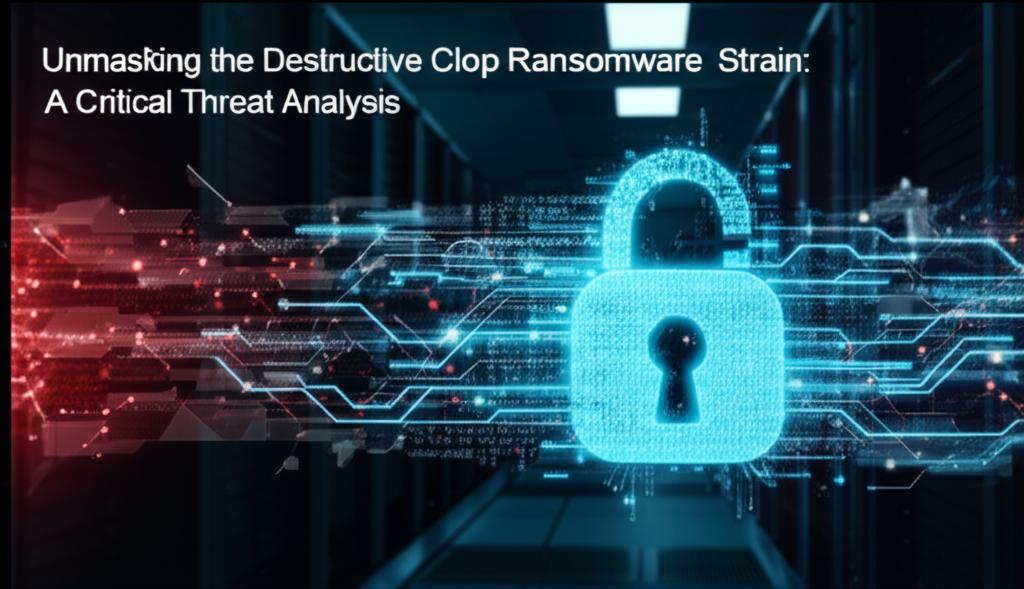Unmasking the Destructive Cl0p Ransomware Strain: A Critical Threat Analysis
The Pernicious Reach of Cl0p Ransomware: Unmasking a Persistent Cyber Threat
In the ever-evolving landscape of cyber threats, Cl0p ransomware has carved out a notorious reputation as one of the most persistent and destructive strains. Operated by the sophisticated cybercrime group TA505, Cl0p has been responsible for some of the largest data breaches and extortion campaigns, impacting organizations across various sectors globally. Understanding its mechanics, attack vectors, and the scale of its impact is crucial for developing robust defense strategies.
What is Cl0p Ransomware?
Cl0p ransomware is a type of file-encrypting malware designed to extort money from its victims. First identified in 2019, it specifically targets Windows operating systems and large organizations, often engaging in a ‘double extortion’ scheme. This means that not only does Cl0p encrypt the victim’s files, rendering them inaccessible, but it also exfiltrates sensitive data before encryption. If the ransom is not paid, the threat actors then threaten to publish the stolen data on their leak sites, adding immense pressure on the victim to comply.
The name “Cl0p” itself is derived from the .Cl0p file extension often used to rename encrypted files. The operators behind Cl0p ransomware are known for their meticulous planning, advanced evasion techniques, and their ability to exploit zero-day vulnerabilities in widely used software.
How Cl0p Ransomware Operates: Attack Vectors and Modus Operandi
The modus operandi of the Cl0p ransomware group typically involves a multi-stage attack:
- Initial Access: Cl0p operators gain initial access through various methods, including phishing campaigns, exploitation of unpatched vulnerabilities in public-facing applications (like VPNs, web servers, or managed file transfer solutions), or brute-forcing Remote Desktop Protocol (RDP) credentials.
- Network Reconnaissance and Lateral Movement: Once inside, they conduct extensive network reconnaissance to map the network, identify valuable data, and locate backup systems. They use legitimate tools and techniques to move laterally across the network, often escalating privileges.
- Data Exfiltration: Before encryption, Cl0p operators prioritize exfiltrating large volumes of sensitive data. This includes customer information, financial records, intellectual property, and internal communications, forming the basis for their double extortion tactic.
- Encryption: Finally, they deploy the Cl0p ransomware payload to encrypt files on as many systems as possible, including servers, workstations, and network shares. The ransomware uses strong encryption algorithms, making data recovery without the decryption key virtually impossible.
- Ransom Note and Extortion: A ransom note is dropped on affected systems, instructing victims on how to contact the attackers, usually via a Tor-based chat service, to negotiate payment, typically demanded in cryptocurrency like Bitcoin.
Notable Attacks and Campaigns by Cl0p Ransomware
The cybercriminals behind Cl0p ransomware have been linked to several high-profile incidents, demonstrating their capacity for significant disruption:
- Accellion FTA Breach (2020-2021): Cl0p exploited a zero-day vulnerability in Accellion’s File Transfer Appliance (FTA) software, affecting numerous organizations, including major corporations and government entities.
- Fortra GoAnywhere MFT Exploit (2023): The group leveraged another critical vulnerability in Fortra’s GoAnywhere MFT (Managed File Transfer) solution, impacting hundreds of organizations by stealing data before encrypting it.
- MOVEit Transfer Vulnerability (2023): Perhaps the most impactful campaign, Cl0p ransomware exploited a critical SQL injection vulnerability (CVE-2023-34362) in Progress Software’s MOVEit Transfer managed file transfer product. This led to a global data breach affecting thousands of organizations and millions of individuals, underscoring the severe consequences of supply chain attacks. The scale of this breach cemented Cl0p ransomware as a top-tier threat.
The Devastating Impact and Far-Reaching Consequences
The impact of a Cl0p ransomware attack extends far beyond the immediate financial cost of the ransom:
- Financial Losses: This includes ransom payments (if made), recovery costs, forensic investigation expenses, legal fees, and potential regulatory fines.
- Operational Disruption: Business operations can be halted for extended periods, leading to lost revenue, decreased productivity, and damage to customer trust.
- Reputational Damage: Public disclosure of a breach can severely harm an organization’s reputation and brand image, affecting customer loyalty and investor confidence.
- Data Privacy Breaches: Stolen sensitive data can lead to identity theft, fraud, and a loss of public trust, with lasting consequences for affected individuals.
Fortifying Defenses: Prevention and Mitigation Strategies Against Cl0p Ransomware
Defending against Cl0p ransomware requires a multi-layered, proactive approach:
- Patch Management: Regularly update and patch all software, operating systems, and firmware, especially for public-facing applications, to close known vulnerabilities that Cl0p ransomware might exploit.
- Multi-Factor Authentication (MFA): Implement MFA for all accounts, particularly for remote access, privileged accounts, and cloud services, to prevent unauthorized access even if credentials are stolen.
- Strong Backup and Recovery: Maintain regular, offline, and immutable backups of all critical data. Test recovery procedures frequently to ensure data can be restored efficiently after an attack.
- Network Segmentation: Segment networks to limit lateral movement and contain the spread of ransomware, reducing the attack surface.
- Employee Training: Conduct regular cybersecurity awareness training to educate employees about phishing attacks, social engineering, and safe browsing practices.
- Endpoint Detection and Response (EDR): Deploy EDR solutions to monitor endpoints for suspicious activity, detect threats in real-time, and enable rapid response.
- Incident Response Plan: Develop and regularly test a comprehensive incident response plan for ransomware attacks, outlining roles, responsibilities, and procedures for containment, eradication, and recovery.
Conclusion: A Continuous Battle Against Evolving Threats
Cl0p ransomware remains a significant and evolving threat in the cybersecurity landscape. Its operators continually adapt their tactics, as evidenced by their repeated exploitation of zero-day vulnerabilities in widely used software like MOVEit Transfer. For organizations, continuous vigilance, proactive security measures, and a robust understanding of the Cl0p ransomware threat are not just recommendations but critical imperatives for protecting valuable assets and ensuring operational continuity in the face of persistent cybercrime.







